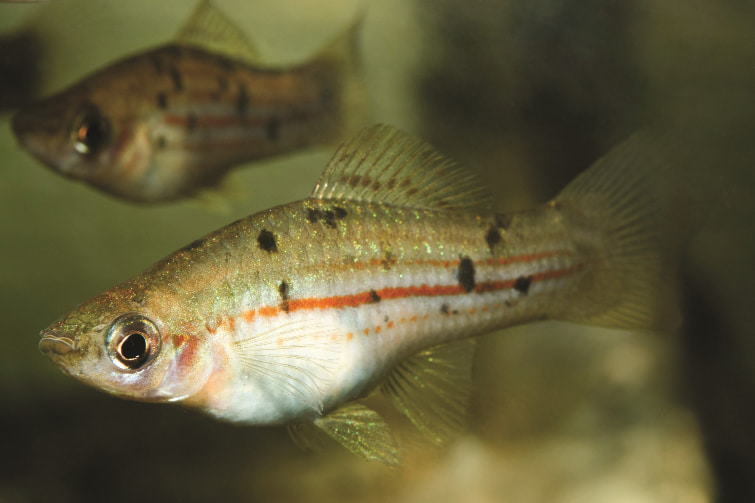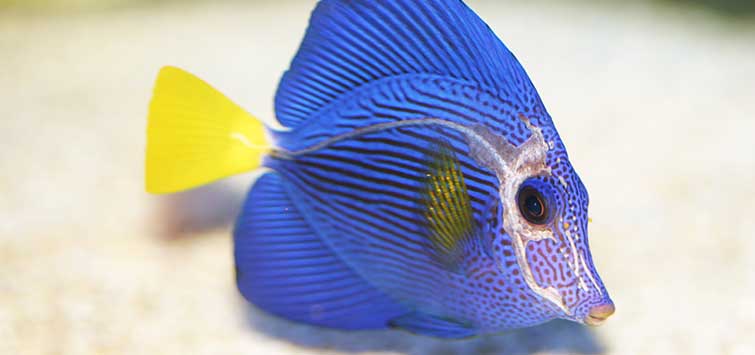Old Tank Syndrome: Problems & Solutions
Nora Hickey, DVM & Jennifer Reynolds, MA
A mature aquarium is a miniature ecosystem in delicate balance. Sometimes the smallest changes can have large consequences, whether that is a population boom of fry from adding a female platy or an algal takeover from someone overfeeding your fish while you were away.
The problems that most commonly arise in mature aquariums are different from those that happen in newly established aquariums.
A fish tank that looks like pea soup or a mycobacteria outbreak does not mean it is time to throw in the towel on your fishkeeping hobby, however. A combination of routine aquarium maintenance, elbow grease, and the right equipment can get your mature aquarium back to a place where you can sit back, relax, and enjoy your fishkeeping hobby again!
Old Tank Syndrome
Having a sufficient population of beneficial bacteria in the biofilter of a new tank is critical to preventing water quality problems such as ammonia and nitrite toxicity when establishing a new aquarium, as we discussed in our first article in this series (“Getting Started on the Right Fin: Aquarium Startup Basics,” TFH Sep/Oct 2024). In an established tank, these bacteria are busily converting ammonia to nitrite and nitrite to nitrate, a process that reduces both carbonate and bicarbonate. Carbonate and bicarbonate, also referred to as alkalinity, carbonate hardness, and KH, serve another important role in your aquarium: working as buffers to keep the pH stable.
When enough carbonate and bicarbonate are present, they prevent large pH swings. The loss of buffering capacity will make the pH become unstable and decrease. The low pH makes ammonia shift to the less toxic form, ammonium, which fish can often live with until a water change is performed.
But, when that water change is performed, it results in an increase in pH. The pH increase is physiologically stressful on its own, and it also makes the ammonium shift back to the more toxic ammonia. Hobbyists call this type of water quality problem old tank syndrome, and it results in fish dying immediately after a water change.
Fortunately, old tank syndrome is easy to prevent. Carbonate and bicarbonate are present in your tap water, so the water you add to your aquarium during your regular water changes (at least a 20 percent water change once a month is a good regimen to start with) replenishes these compounds. If your tap water is low in alkalinity, sources of bicarbonate, including crushed coral and aragonite sand, can be used as a supplement.
Be aware that water sources such as distilled water and reverse osmosis water do not contain carbonate or bicarbonate (the processes of distillation and reverse osmosis remove these and other chemicals), so performing water changes with them will not replenish alkalinity. These are not recommended water sources for beginner freshwater aquariums and generally are only used for maintaining species that like very soft, acidic water or as make-up water for saltwater aquariums.
Algal Overgrowth
There is another benefit to performing regular water changes, and that is nutrient control for nitrate and phosphate. Nitrate is the end product of your aquarium’s nitrogen cycle, and it accumulates in the water until it is removed either through water changes or by plants and algae (which may remove the nitrogen in previous stages).
Phosphates arrive in the aquarium as part of many foods, particularly those that are high in protein. They may also be a part of additives, especially in certain vitamins and minerals. These nutrients are necessary for plant growth, but they can also fuel algal growth.
Algae use nutrients, including nitrate and phosphate, combined with carbon dioxide and light to grow. When nutrients and light are plentiful, algae growth in an aquarium can easily get out of control. Algal overgrowth comes in many different forms, including water that looks like pea soup, hair algae all over plants and decorations, and greenish-brown growth covering the aquarium walls and obscuring your view of your fish. Although battling algal overgrowth can be annoying for fishkeepers, it doesn’t usually cause problems for the fish, which might even enjoy it as a snack!
Controlling nutrients and light are both critical for limiting algal growth. Avoiding overfeeding and keeping up on regular water changes lessen the nutrients available to the algae. Limiting the light exposure and intensity by keeping your aquarium out of direct sunlight, minimizing the amount of time that the aquarium light is on, and using dimmable lighting when possible also prevent algal growth.
One trick for lighting is to use a timer to program a split photoperiod where the light is on for several hours in the morning and evening, perhaps before and after work so you can enjoy viewing your fish, but off for a few hours in the middle of the day.
Live plants can also help to limit algae by outcompeting it for available nutrients. The use of floating plants such as frogbit or water sprite is particularly effective, because these plants both block some light from reaching the rest of the tank and can access atmospheric carbon dioxide to help fuel their uptake of excess nutrients in your aquarium. Hornwort and other easy and fast-growing plants can make a significant difference, too.
But even with the most diligent nutrient and light control, some algae will still grow in the little ecosystem that is your aquarium. Scrubbing decorations and gently cleaning the glass with a non-scratching cleaning pad are necessary parts of your regular maintenance routine. The frequency may vary greatly, with some aquarists needing to scrub the glass even daily, and most needing to do so about once a week.
Some aquarium inhabitants, like shrimp, snails, and certain fish species, can help you with algae control, but they usually can’t do it all themselves. And don’t forget that even if you add a clean-up crew to your tank, it will usually need supplemental food sources beyond just naturally growing algae.
Mycobacteriosis
You can avoid introducing many pathogens, including some parasites like ich, by properly quarantining new arrivals, as discussed in our second article in this series (“Getting Your Sea Legs: What to Consider When Stocking a First Aquarium,” TFH Nov/Dec 2024). However, some infectious diseases will still make it into your aquarium, and one of the most ubiquitous and insidious of these is mycobacteriosis, also called myco or fish tuberculosis.
Mycobacterium species that infect fish are bacteria that are present everywhere in the aquarium hobby. Mycobacterial infections are often chronic, which means that infected fish can appear perfectly healthy for a long time and be very slow to develop disease. The most classic presentation of this disease in a home aquarium is older fish wasting away. Disease can progress more rapidly in species that are highly susceptible to mycobacteriosis, including rainbowfish.
Like most fish diseases, mycobacteriosis cannot be diagnosed just by looking at a sick fish. The best way to accurately diagnose and effectively treat fish diseases is by working with a fish veterinarian. They can be hard to find, but a good place to start is using the American Association of Fish Veterinarians’ “Find a Fish Vet Locator” at fishvets.org. Fish veterinarians have the knowledge and experience to diagnose mycobacteriosis via necropsy and such diagnostics as cytology and histopathology, and they can help you implement the most effective treatment.
Some sources recommend breaking down a tank with mycobacteriosis, disinfecting it, and starting over. But because Mycobacterium are everywhere and your new tank is highly likely to get reinfected as soon as you stock it with fish again, we believe long-term management strategies can be very effective for keeping this disease under control in a home aquarium.
One of the most important things that fishkeepers should know about mycobacteriosis is that, while it is a bacterial infection, it cannot be effectively treated with antibiotics. This is because mycobacteria live inside a fish’s white blood cells, which protects the bacteria from antibiotics.
There are other strategies that can be deployed to fight mycobacteriosis in a home aquarium. The most important action during mycobacteriosis or any disease outbreak is to maintain excellent hygiene by performing large, frequent water changes, removing uneaten food and detritus immediately, and reducing biofilms (a layer of microorganisms that coat a surface and where pathogens can hide) by keeping the glass and filter scrubbed and clean.
Small ultraviolet filtration units can also play a role in reducing the population of pathogens in an aquarium, including mycobacteria. Although they do not completely sterilize the water, reducing the bacterial load lowers the infectious dose your fish are exposed to.
Another important part of reducing the pathogen load in an aquarium is to promptly remove any fish that appear sick from the main population. While it may be tempting to leave a sick fish in its home aquarium to give it a chance to recover, doing so could allow it to shed bacteria into the water. The bacteria it is shedding then go on to infect and sicken other fish in the tank. Sick fish should be housed in a separate hospital tank or humanely euthanized, as fish affected by mycobacteriosis will not recover. This can be a difficult decision to make, but it is a critically important step in infection control.
One other important thing to mention when discussing mycobacteriosis is that while it is not the same species of bacteria as Mycobacterium tuberculosis, which causes tuberculosis in humans, it can cause localized skin infections in immunocompromised individuals. It is unlikely for people to become infected with Mycobacterium that infect fish; however, if you have concerns, you should discuss this with your doctor.
Basic precautions like avoiding exposing any open wounds to aquarium water and wearing protective equipment such as long, waterproof gloves while working in your tanks should be sufficient protection against any infections with these bacteria even if you are immunocompromised.

Expanding Fish Populations
Maybe you are doing regular water changes, do not have a single speck of algae, and all your fish are perfectly healthy—but they are breeding like crazy, and your aquarium is starting to look a bit crowded!
Things can get a little out of control when fish start breeding, especially prolific livebearers like platys or swordtails, or cichlids such as fairy or convict cichlids, which do such a good job of protecting their fry that they will easily overpopulate an aquarium left unchecked. And then you realize that your cory catfish are looking skinny because no food is making it past the mass of platys!
Maintaining your fish population at a level that is appropriate for your tank will help you avoid the problems that come with overstocking. If your fish are constantly producing new offspring, consider selling the juveniles to your local fish store or at a fish club auction. A more natural option is to add predatory fish that can help with fry control.
In the face of a booming population of upper and mid-level swimmers, or aggressive feeders like many juvenile cichlids, it is easy to forget some of the more reclusive fish in your aquarium.
Sometimes they’re just very good at hiding or only come out after the lights are out. These types of fish often require some special attention and care to thrive long-term in your aquarium.
For fish that feed from the bottom, including cory cats and loaches, adding sinking food in the evening will ensure that they are receiving adequate nutrition and not relying solely on leftover flakes fed to the other fish. And for more specialized feeders, such as bristlenose plecos, regularly providing vegetables, including lettuce leaves and zucchini slices, will ensure that they have adequate food.
Fishkeeping for Life!
With this fourth and final installation in our aquarium beginner series, we hope you have the information you need to establish a successful and enjoyable first aquarium. We didn’t warn you at the beginning, but this is a highly addictive hobby. Now that you have mastered the basics and are hooked on fishkeeping, it is time to start planning your next fishkeeping pursuit—whether that is setting up a new cichlid tank or blackwater biotope, getting into live food cultures, or trying to breed some of your current fish. Happy fishkeeping!
For more advice from Nora and Jen, including in-depth articles and conversations about mycobacteriosis, visit fishkeepandchill.com.

.png?h=595&iar=0&w=2781&hash=5FD5E69473BCC22199FBFA2FB71B6033)




